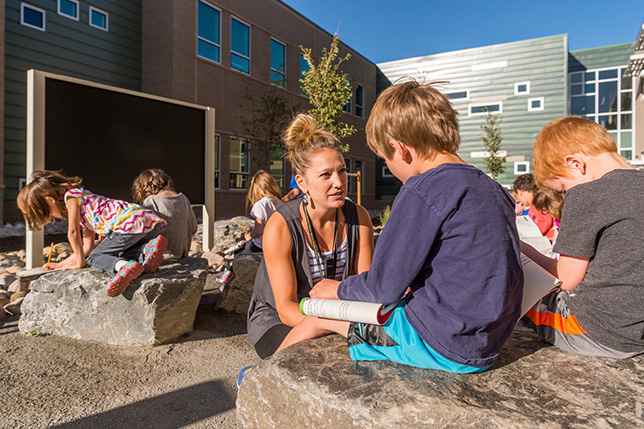How to Create Successful Outdoor Learning Spaces
By Adele Willson and Robyn Bartling
Outdoor learning spaces and classrooms have become a necessary element of successful next generation learning environments. We have seen firsthand the benefits of integrating the outdoors into the learning environment options to create a holistic, healthy, and stimulating environment for students and teachers.
Research has shown that outdoor learning can have substantial benefits on student mental health and academic performance, including reducing stress, promoting wellness, and improving focus and academic achievement. We have observed this to be true in our work and have received testimonials from teachers and administrators at our schools noting the ways that outdoor education and play support emotional, behavioral, and intellectual development in children of all ages, while teaching children an understanding and respect for nature and the environment.
As national leaders in K-12 education design, we have seen the benefits that outdoor learning provides for both students and educators. Our team has developed several keys to designing successful outdoor spaces. We also have compiled several “lessons learned” and case studies to provide schools interested in outdoor learning with resources.

Three Creeks K-8
©Scott Dressel-Martin
Benefits of Outdoor Learning
There are three primary benefits to outdoor learning environments. These next generation spaces:
- Support and encourage development of healthy and active lifestyles
Outdoor learning connects students to nature and promotes a sense of well-being.
- Increase ability for students to focus and strengthen cognitive abilities
Outdoor learning improves academic achievement and enhances decision-making and problem-solving skills.
- Help social and emotional health and wellbeing
Having access to the outdoors allows students to reduce stress through movement and fresh air, as well as providing space for social interactions and hands on-learning.
5 Keys to Success
Through our extensive experience designing outdoor learning spaces across the country, we have developed five keys for designing successful projects. We believe these key elements play an important role in the design of successful learning spaces that create opportunities for connection with the environment and other students.
- Collaboration during Design: We work closely with educators and administrators during the early design process to discuss the needs and desires of the school. Stakeholder engagement meetings allow for collaborative review of design concepts and incorporation of feedback, resulting in a design that is guided by the final users.
- Indoor/Outdoor Connection: Visibility within the school to the outdoors, direct connections between indoor/outdoor spaces, and incorporation of biophilic design are key to creating healthy learning spaces that support student wellbeing. This connection can be achieved through a variety of methods, including ample windows and daylighting, garage doors that can be opened when the weather allows, and the use of natural materials and other interior finishes that mimic patterns and colors found in nature.
- Flexible and Inclusive: In order to create a space that is highly utilized, designers must take flexibility and inclusivity into account. By designing an easily adapted space, the outdoor classroom can be used for social gatherings as well as small and large group education. In addition, these flexible spaces allow for various pedagogical methodologies.
- Integration with Play: The integration of outdoor learning spaces and play areas allows students to learn organically, utilizing both amenities for education and play. Through the use of natural materials and educational features, it is possible to create holistic spaces that support student growth.
- Exposure, Access and Safety: Design considerations must include recommendations for protection from sun, snow, rain and wind, as well as secure and/or safe and visible access from the school building and the surrounding community. Often, we design outdoor classrooms in protected courtyards or other naturally secure and visible areas.
Case Study: Thunder Vista PK-8
Thunder Vista PK-8 is a new school serving 1,000 students. Located in Broomfield, Colo., the school incorporates many next generation learning concepts throughout, including several outdoor learning spaces. Four years after the school’s completion in 2018, our design team went back to the school to interview educators and administrators on how they were utilizing their outdoor classrooms.
“We try to incorporate the [outdoor learning spaces] as much as we can into the units and lessons that teachers are teaching. They are particularly great spaces to use when you think about science lessons or any kind of STEAM lessons,” said Principal Teresa Benallo. “We also have a garden space outside, too, that has been really great for our afterschool clubs.[…] Those have created really exciting lessons for the kids as well.”
“I love the outdoor learning space. Going outside when it’s nice out and being able to do math out there, just questions, fun games and a space to get pictures or do our STEAM projects […] it’s a fun place to be on both sides,” said teacher Katie Tennant. “Some benefits I’ve seen from outdoor instruction have been that they’re more engaged in the learning. When we do our plant unit, they’re able to see the lifecycle of the plant, from planting to harvesting to preparing the garden for winter.”
Conclusion
Through our ongoing research and extensive experience, we continue to see the manifold benefits that outdoor learning spaces offer to both students and educators. These next generation learning environments support academic, physical, and emotional growth and wellbeing, as well as provide flexible alternatives to standard classrooms. By utilizing our five keys to success, we are able to work alongside our clients to design spaces that meet a variety of needs and are quickly become favorite learning amenities.
Adele Willson, AIA, LEED AP, ALEP, is a K-12 Principal, and Robyn Bartling, PLA, ASLA, is a Landscape Architecture Principal with Hord Coplan Macht.